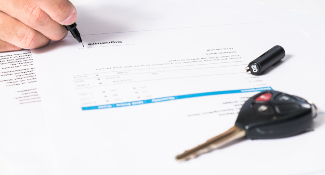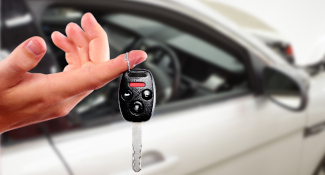Ready to seal the deal but wondering “What paperwork do I need to sell my car?” To sell your car privately, the short answer is that you’ll need your title and registration, at a minimum.
Here's a quick rundown of what you'll likely need:
- Title
- Odometer reading
- Maintenance records
- Emissions documentation
- Vehicle history report
- Warranty documents
- As-Is document
- Bill of sale
The fact is that each state has specific requirements when it comes to selling vehicles and the paperwork required to complete a sale. A rundown on the most common documents and paperwork needed for a successful car sale can help ensure that your transaction goes through smoothly and efficiently and you get as close to your asking price as possible.
Here's a more detailed look at the potential documents you'll need:
The Title:
If you don’t owe anything on your car, then you likely have what is known as a “clear” title. This means the title is unencumbered by liens to third parties. Selling a car with a clear title is fairly straightforward, although the procedure and paperwork necessary to complete the sale and the title transfer vary by state. Usually, you’ll just sign the title in front of a notary, who will stamp the title to signify that you did, in fact, sign it. The protocols for switching ownership of a car between the buyer and the seller are usually quite simple if there are no financial institutions or other lienholders involved.
Things can get complicated if you’ve lost the title and need to get a duplicate title made. Similarly, the sales process can be a bit of a hassle if you still owe on your car. You may or may not have a copy of the title in hand if you’re still paying for the car, although this varies (again) by state. If you’re selling a car that has a lien, you and your buyer will need to work with the finance company or lender (and possibly the bank or finance company the buyer uses) to affect the transfer of the title.
Odometer Reading:
In most states, when you sign the title to the vehicle as a seller, you will need to disclose the vehicle’s odometer reading. There may be an area on the back of the title for the disclosure of the odometer mileage, or you may need to fill out a separate disclosure document—or both.
An odometer disclosure form typically requires the following information:
The vehicle’s description, including the year, make, model, and vehicle identification number (VIN);
The name, address, and signature of the new owner or person buying the car;
The name, address, and signature of the person selling the car;
The current mileage;
The signature and/or seal of the notary public certifying the transaction;
The physical presence of the vehicle’s title.
If you don’t have a clean car title, the easiest way to sell your car is to use it as a trade-in at a dealership when buying a preowned or new car. You’ll simply sign your name on the title and a few documents, and the dealership (who has oodles of experience selling cars) handles the rest. This is especially true if there are liens to be satisfied prior to the transfer of ownership.
Emissions Documentation:
A smog check may be necessary if you live in a state that requires it. For example, the California DMV has strict requirements for emissions that must be met. Check with your local DMV to find out what the requirements are for smog or emissions testing and smog certification prior to selling your car.
Vehicle History Report:
These days, hardly anyone buys a used car without seeing a vehicle history report. When you place your car ad, you will probably add your vehicle identification number to your ad. A VIN allows prospective buyers to look up your vehicle's history. If you're the first owner of your vehicle, that may be all you need. However, if you're not, you may want to take a look at the vehicle history report yourself via a website such as Autocheck or CarFax to prepare for questions that buyers might have and to validate the car’s value.
Maintenance Records:
It's easy to say in your ad that your car has been well-maintained, but it's even better to have actual proof of this. Whether you did your own maintenance or had it done at a dealership or repair shop, any kind of record is valuable to prospective buyers and can help you get the best price for your car. If you performed your vehicle's maintenance yourself, then records of the parts you bought can suffice.
Warranty Documents:
If you happen to have a remaining warranty on your car that is transferable, then you'll want to have this on hand as well. Having this available can also justify a higher price on your vehicle. However, it's essential to have proof of this warranty ready for the potential buyer to see. It's also a good idea to have some contact information so that the buyer can quickly contact the provider and get the warranty in their name.
As-Is Document:
So you can protect yourself and make things clear to prospective car buyers, have something in writing indicating that your car will be sold as-is. That means that you're not offering any warranties or buyback on the vehicle. By signing it, the buyer agrees that they are accepting all responsibility for the vehicle's condition and future repairs. After you receive payment, and the vehicle changes hands, then the matter is legally done.
Bill of Sale:
A bill of sale isn't generally an absolute requirement, but it's a good idea to have for the release of liability. This document lists the comprehensive terms of the sale. You can add the vehicle description, the odometer reading, the price, delivery date, statement of as-is condition, and the signatures of the buyer and seller. You can also get it notarized if you wish, and if you do, you'll need to prove your identity, so take your driver's license along. If there's any dispute after the sale, the signed-around bill of sale can protect you from any liability.
The Bottom Line:
As you can see, when it comes to the query “What paperwork do I need to sell my car,” the answer is a little convoluted and depends on where you live and whether you’re selling your car to a private party or trading it in at a dealership. The very least you’ll need is a clear certificate of title for the car. However, you may need to present the vehicle’s registration documents, provide the seller and the DMV with a sworn statement regarding the car’s odometer reading, and create a Bill of Sale that includes information such as the vehicle’s sales price, date of delivery, mileage, and a description of the car. What’s more, if the vehicle is under warranty, you need to present the buyer with documentation regarding the warranty.
Be certain that you’re prepared with the appropriate paperwork to sell your car in your state by visiting your state’s official Department of Motor Vehicles or DMV website. These handy links will get you where you’re going and provide you with additional state-specific details for selling your car.


